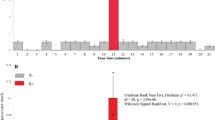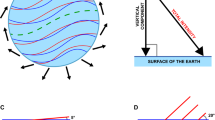Summary
-
1.
Yellowfin tuna,Thunnus albacares, were trained individually to discriminate between two Earth-strength magnetic fields by differential reinforcement of a swimming response.
-
2.
Seven subjects, of which two were trained with a double blind procedure designed to control for the possibility of cues from the experimenter, learned to discriminate between ambient and altered fields (Figs. 1–3).
-
3.
Two additional fish trained with the same double blind procedure failed to discriminate between two magnetic fields in which the gradients of intensity were equal and opposite (Fig. 4).
-
4.
The results suggest that the responses to magnetic fields by yellowfin tuna are neurally mediated and that magnetic field detection by this species can be analyzed by the same means as other sensory modalities.
Similar content being viewed by others
Abbreviations
- ITI :
-
intertrial interval
References
Beaugrand JP (1976) An attempt to confirm magnetic sensitivity in the pigeon,Columba livia. J Comp Physiol 110:343–355
Bitterman ME (1979) Discrimination. In: Bitterman ME, Lo-Lordo VM, Overmier JB, Rashotte, ME (eds) Animal learning: Survey and analysis. NATO Adv Study Inst Ser, Ser A, Life Sci 19. Plenum Press, New York London, pp 413–443
Bookman MA (1977) Sensitivity of the homing pigeon to an Earth-strength magnetic field. Nature 267:340–342
Griffin DR (1982) Ecology of migration: Is magnetic orientation a reality? Q Rev Biol 57:293–295
Jemison HA III, Dizon AE, Walker MM (1982) An automatic feeder for liquids and wet or dry solids. Behav Res Methods Instrum 14:54–55
Jungerman RL, Rosenblum B (1980) Magnetic induction for the sensing of magnetic fields by animals — An analysis. J Theor Biol 87:25–32
Kalmijn AJ (1974) The detection of electric fields from inanimate and animate sources other than electric organs. In: Fessard E (ed) Electroreceptors and other specialized receptors in lower vertebrates. (Handbook of sensory physiology, vol III/3) Springer, Berlin Heidelberg New York, pp 147–200
Kalmijn AJ (1978) Experimental evidence of geomagnetic orientation in elasmobranch fishes. In: Schmidt-Koenig K, Keeton WT (eds) Animal migration, navigation, and homing. Springer, Berlin Heidelberg New York, pp 347–353
Kirschvink JL, Gould JL (1981) Biogenic magnetite as a basis for magnetic field detection in animals. Biosystems 13:181–201
Kling JL (1971) Learning. Introductory survey. In: Kling JW, Riggs LA (eds) Woodworth & Schlosberg's experimental psychology. Holt, Rinehart and Winston, New York Chicago San Francisco Atlanta Dallas Montreal Toronto London Sydney, pp 551–613
Kreithen ML, Keeton WT (1974) Attempts to condition homing pigeons to magnetic stimuli. J Comp Physiol 91:355–362
Mackintosh NJ (1974) The psychology of animal learning. Academic Press, London New York
Ossenkopp K-P, Barbeito R (1978) Bird orientation and the geomagnetic field: A review. Neurosci Biobehav Rev 2:255–270
Phillips JB (1977) Use of the earth's magnetic field by orienting cave salamanders (Eurycea lucifuga). J Comp Physiol 121:273–288
Queenth MKK, Brill RW (1983) Operations and procedures manual for visiting scientists at the Kewalo Research Facility. Southwest Fish Cent Adm Rep H-83-7, 16 pp. Southwest Fish Cent, Natl Mar Fish Serv, NOAA, Honolulu, Hawaii 96812
Reille A (1968) Essai de mise en évidence d'une sensibilité du pigeon au champ magnétique à l'aide d'un conditionnement nociceptif. J Physiol (Paris) 60:85–92
Tesch F-W (1980) Migratory performance and environmental evidence of orientation. In: Ali MA (ed) Environmental physiology of fishes. NATO Adv Study Inst Ser, Ser A, Life Sci 35:589–612
Walker MM, Kirschvink JL, Chang S-BR, Dizon AE (1984) A candidate magnetic sense organ in the yellowfin tuna,Thunnus albacares. Science 224:751–753
Woodard WT, Bitterman ME (1974) A discrete-trials/fixed-in-terval method of discrimination training. Behav Res Methods Instrum 6:389–392
Yorke ED (1979) A possible magnetic transducer in birds. J Theor Biol 77:101–105
Yorke ED (1981) Sensitivity of pigeons to small magnetic field variations. J Theor Biol 89:533–537
Author information
Authors and Affiliations
Rights and permissions
About this article
Cite this article
Walker, M.M. Learned magnetic field discrimination in yellowfin tuna,Thunnus albacares . J. Comp. Physiol. 155, 673–679 (1984). https://doi.org/10.1007/BF00610853
Accepted:
Issue Date:
DOI: https://doi.org/10.1007/BF00610853




